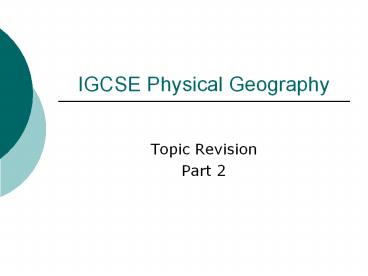IGCSE Physical Geography - PowerPoint PPT Presentation
1 / 12
Title:
IGCSE Physical Geography
Description:
IGCSE Physical Geography Topic Revision Part 2 Ecosystems An ecosystem is a natural system in which life cycles of plants and animals are closely linked to each other ... – PowerPoint PPT presentation
Number of Views:398
Avg rating:3.0/5.0
Title: IGCSE Physical Geography
1
IGCSE Physical Geography
- Topic Revision
- Part 2
2
Ecosystems
- An ecosystem is a natural system in which life
cycles of plants and animals are closely linked
to each other and to the non-living environment
(water, air, rocks soils). - Ecosystems can vary in size from Global to Micro.
- Ecosystems are sustained by the energy flow
through it starting with plants converting the
suns energy (photosynthesis) then through the
food chains trophic levels.
3
Ecosystem Nutrient Cycle
Dying organisms
(living matter)
(leaf fall)
Decomposition
4
Ecosystem Interactions Diagram
- Relief
- Climate Soils
- Vegetation
5
Biomes (Global Ecosystems)
- 4 main biome climates
- Equatorial
- (High constant temperatures, High convectional
rainfall) - Tropical Continental
- (Seasonal hot wet cooler dry)
- Hot Desert
- (High annual temp temp range, high daily temp
range, very low rainfall) - Mediterranean
- (moderate annual temp, temp range rainfall.
- Seasonal hot dry summers, warm wet winters)
6
- Biomes - Vegetation
- Equatorial
- (Luxuriant rainforests with continuous growing
seasons. - thin fertile soil layer)
- Tropical Continental
- (diverse vegetation from rainforest to savannah
xerophytic to desert) - Hot Desert
- (sparse vegetation drought resistant)
- Mediterranean
- (Originally woodland scrub now deforested for
agricultural development)
7
Plate Tectonics
- The theory that the earths crust is made up of
plates that move (continental drift) due to
convection currents in the earths mantle. - Where plates meet is called a plate margin.
- These margins can be
- Destructive (plates converging subduction or
folding/faulting) Violent EQs Volcanoes - Constructive (plates move apart oceanic ridges)
Gentle Volcanoes weak EQs - Conservative (plates move past each other)
Frequent, sometimes violent EQs
8
Effects of Plate Tectonics
- Plate Tectonics is the cause of most Earthquakes
and Volcanoes. - There is a clear pattern between the distribution
of EQs / volcanoes and plate margins. - The formation of many of the worlds landforms
are associated with tectonics e.g. the Himalayas,
the Andes, The Pacific Ring of Fire .. etc.
9
Volcanoes
- Volcanoes can be classified several ways
- By activity (active, dormant, extinct)
- Shape/Composition (cone shaped ash composite,
shield) - Cone shaped thick slow moving lava gtgt steep
sided - Shield runny fast moving lava (basaltic)gtgt
gentle slope - Hazards from Volcanoes
- Lava flows, Lahars, Dust Ash clouds, Nuee
ardentes. - Benefits from Volcanoes
- Fertile soil, geothermal energy, rocks for
building, tourism
10
Earthquakes
- An earthquake is the vibration of the Earths
crust caused by shock waves travelling outwards
from sudden movement deep within the crust. - The source is the focus which is directly below
the epicentre on the surface. - Shockwaves are measured on a seismograph which
measures the magnitude on the Richter scale. - Impacts include Primary (deaths/injury, building
collapse, damage to infrastructure) Secondary
(fire/flood, lack of services, disease, homeless,
unemployment, psychological) - Factors affecting impacts strength depth,
distance from epicentre, geology, population
density (urbanisation), time of day or season,
remoteness, country wealth/location.
11
Earthquake Prediction Preparation
- It is not possible to predict EQs with any
accuracy but there are some signs (increased
tremors, unusual animal behaviour, gas emissions
from ground). - However cities in high risk areas can prepare by
- Land use planning building codes
- Improved building design (EQ resistant buildings)
- Emergency plans (Civil Defense) and evacuation
procedures. - Public education of how to prepare and what to do
during and after an earthquake.
12
Case Studies
- Volcanoes
- Mt St Helens (1980)
- Earthquakes
- Kobe, Japan (1995)































